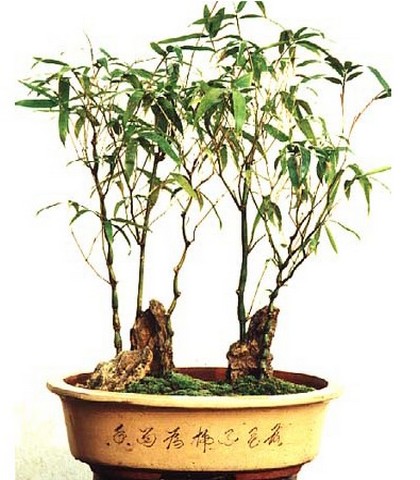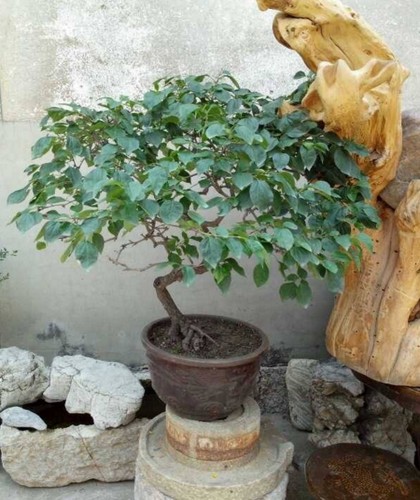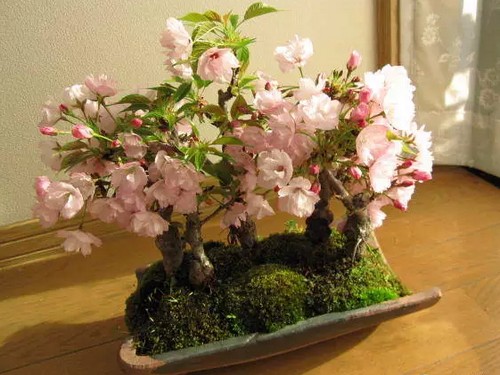The method of making bonsai of Buddha belly bamboo
Since ancient times, the literati and elegant guests all like bamboo and think that it has the air of a gentleman. Indeed, it is vigorous and straight, handsome and elegant, frost and snow does not wither, evergreen all the year round, it is indeed not vulgar. If you also love bamboo, but there are no rural bamboo forests around, then come and make it into a bonsai, please come home.

At this time, Buddha belly bamboo is a good choice, this kind of bamboo plant is shorter, bamboo seedlings are green, old bamboo is orange. The difference between Buddha belly bamboo and ordinary bamboo is that the bamboo knot is thin, the internodes are short and inflated, like the belly of Maitreya Buddha, but also like a folded Luohan, so it is also called Luohan bamboo and dense bamboo.
First, modeling and using basin
Bonsai is made of Buddha belly bamboo, mostly in jungle style, to show the natural charm of bamboo forest, but there are also one or two plants to make bonsai. If two Buddha belly bamboos are planted in one basin, they should be large and small, thick and thin, high and low, and always inclined, erect plants should be tall, large and thick, oblique plants should be small, thin and low, with the former as the main and the latter as the auxiliary. If the two plants are similar in size and both are upright, this kind of bonsai is not interesting. According to the size of the pot, 5, 7 and 9 plants are planted in one pot to make jungle-style bonsai. Take 5 plants as an example, according to the plant size, they are divided into No. 1, No. 2, No. 3, No. 4, No. 5. When making, No. 1, No. 3 and No. 4 are often used as the main body of bonsai, and No. 2 and No. 5 are used as the object of bonsai. Play a foil role, and leave a proper distance between the two groups.
In the jungle style, it is better to use a shallow rectangular or oval purple sand basin, followed by a glazed pottery basin. Such as placing some pandas with appropriate size, exquisite workmanship and beautiful shape, it will make bonsai more poetic and picturesque. For example, if you plant three Buddha belly bamboos of different heights in a pot, and then put exquisitely carved rocks in the pot, it will become a beautiful three-dimensional traditional Chinese painting-- "bamboo and stone pictures."
II. Planting and reproduction
The breeding, turning and planting of Phyllostachys pubescens should be in May or September. The method of plant division is often used in reproduction, that is, the plant is deducted from the basin, the persistent soil of the root is removed by bamboo, and the thick roots connected between plants are found and cut off, and then they can be planted. When planting, we should take more lodging soil to improve the survival rate. Combined with ramet and turning basin, the old root, overlong root and withered root should be cut off, and erect branches, drooping branches and over-dense branches should be cut off at the same time, so as to reduce plant water evaporation, benefit survival and make the plant shape more beautiful. Phyllostachys pubescens likes loose, fertile and well-drained acid sandy soil, which is mainly humus soil and a small amount of sandy soil can be used.
Materials & tools:
Materials: Buddha belly bamboo, humus soil and sand soil mixture (bamboo garden soil can also be), utensils
Tools: scissors, small shovels, etc.
Action:
1. Choose a shallow rectangular or oval purple sand basin as a vessel, or a glazed pottery basin.
2. Fill the basin with some mixed soil of humus and sand (bamboo garden soil can also be used).
3. Choose 5 plants of different height and height of Phyllostachys pubescens, when dug out from the soil, bring more persistent soil as much as possible to improve the survival rate. At the same time, the old root, overlong root and withered root of 5 bamboos were cut off, and the dense branches were cut off at the same time, so as to reduce plant water evaporation and be beneficial to survival.
4. Five Phyllostachys pubescens of different height were divided into two groups, of which the taller three were located in the center of the vessel as the main body, and the shorter two were on both sides as a foil, and then planted in the basin. Moss and pebbles can be laid on the soil as a landscape.
5. Freshly planted bonsai should be watered thoroughly and maintained in a shaded place for about 10 days, then in a half-shaded and half-sunny place for 5 days, and then carefully maintained in a sunny, well-ventilated, warm and humid environment.
Tips:
1. Buddha belly bamboo likes to be wet, so it should be watered frequently to keep the soil moist, but no water can be accumulated in the basin.
2. Phyllostachys pubescens grows fast, and the branches that are not needed for modeling should be cut off in time so as not to consume nutrition.
Time: 2019-05-26 Click:
- Prev

The method of making lilac bonsai
A shrub or small tree of the genus Syringa, up to 5 m tall; bark grayish brown or gray. Branchlets, inflorescence rachis, pedicels, bracts, calyx, both sides of young leaves and petiole are glabrous and densely covered with glandular hairs. Branchlets thicker, sparsely lenticellate. Leaf blade leathery or thickly papery, ovoid to reniform, panicle erect, drawn from lateral buds
- Next

The method of making Cherry Blossom Bonsai
With bright colors and luxuriant branches and leaves, cherry blossoms are an important ornamental tree species in early spring and are often used in gardens. Group planting can also be planted on hillsides, courtyards, roadsides and in front of buildings. When it is in full bloom, the flowers are colorful, the trees are in full bloom, such as clouds and clouds, it is very spectacular. Can be planted in large areas to create a landscape of flowers.
Related
- Fuxing push coffee new agricultural production and marketing class: lack of small-scale processing plants
- Jujube rice field leisure farm deep ploughing Yilan for five years to create a space for organic food and play
- Nongyu Farm-A trial of organic papaya for brave women with advanced technology
- Four points for attention in the prevention and control of diseases and insect pests of edible fungi
- How to add nutrient solution to Edible Fungi
- Is there any good way to control edible fungus mites?
- Open Inoculation Technology of Edible Fungi
- Is there any clever way to use fertilizer for edible fungus in winter?
- What agents are used to kill the pathogens of edible fungi in the mushroom shed?
- Rapid drying of Edible Fungi

